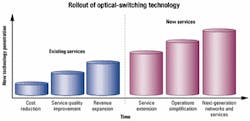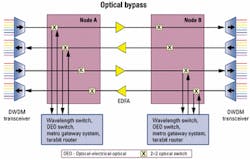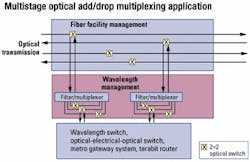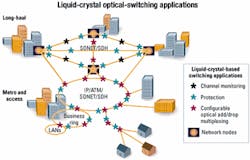Switching to all-optical networks
The path to profitable deployment of optical switching is crystal clear.
HUBERT KOSTAL, SpectraSwitch Inc.
Most agree the deployment of all-optical networks will provide higher-bandwidth services with lower network operations cost than today's mixed optical/electrical network.
Strong arguments exist for expanding the reach of optical networking as close to the service entry point as possible. First, as service bandwidth steadily increases, both for individual customers and in aggregate, fiber-optic transport remains the most effective means for carrying this traffic. Second, optical transport is protocol-independent and relatively speed-insensitive, providing multiple options for service growth. Third, transitions, whether between physical media or protocols, always come at nonzero cost, so minimizing optical-electrical (OE) conversions will reduce the cost of building the network.
Given the state of the industry, can all-optical networks be deployed today? The answer is yes. But deployment will not be a wholesale replacement of existing infrastructure. Instead, it will occur in incremental steps, driven by the physical and economic realities of network operations. Liquid-crystal-based optical-switching technology will have a broad range of applications in the early stages of the deployment of the all-optical network.
What is an "all-optical network"? A pragmatic definition is a network based primarily on optical transport with OE conversions pushed to service aggregation points that are as close to the customer as is economically feasible and concentrated at subwavelength service switching nodes. The objective is a facility and services infrastructure that maintains optical continuity to the maximum extent possible, while recognizing that certain operations, such as subwavelength switching and access, protocol processing, and detailed service management are better served today in the electrical (including wireless) rather than optical domain. Over time, as more operations become possible in the photonic domain and as end-to-end service bandwidths increase, the OE boundary will continue to shift.An all-optical network will be realized through an evolutionary process-a series of small revolutions-because first, there is not just one network, instead there are numerous network service providers. Any significant network or service architectural change must be coordinated (unlikely) or independently implemented (preferred). Second, optical technology is still evolving, with future potential as yet unrealized. That means initial technology deployment must create a basic structure that will permit the deployment of anticipated future capabilities, but prove-in on a standalone basis.
This view takes the position that an all-optical network will be introduced by evolving existing networks. An alternative approach is to build the all-optical network as a green-field network operated by a startup (or upstart) service provider, with the assumption that the ensuing proof of its service and cost superiority will drive incumbents to adopt the same technology or lose market leadership. The general lack of success of the competitive local-exchange carriers that adopted the latter approach demonstrates that economics, not technology, is the determining success factor. Building network capacity, no matter how efficiently, with the expectation that revenue will follow automatically is no longer practical.In intelligently evolving to the all-optical network, cost reduction, service quality improvement, and revenue expansion are the motivation for the carrier. These steps are followed by the addition of new services and supporting bandwidth and switching in synchronization with customer demand (see Figure 1).
The breadth of optical-switching technologies today (micro-electromechanical systems-MEMS, optomechanical, thermo-optic, acousto-optic, magneto-optic, electro-holography, bubble, PLC, and liquid crystal) are rarely presented in terms of network evolution. These optical technologies are addressing applications from wholesale replacement of networks to optical packet switching to enabling 40-Gbit/sec and greater transmission speeds to the elimination of existing broadband digital-crossconnect systems to protection switching. All these applications will be required for the future all-optical network, but for early adoption, the key attributes are application fit; ease of adoption; proven reliability, durability, scalability; and a road map to integrated optical functionality. These attributes are not uniformly satisfied by any one technology. Cost reduction, service quality improvement, revenue expansion, and new services can be enabled using optical-switching technologies-just how will suggest some technology directions.
Reducing the cost of network operations and delivering services is the primary reason for introducing new technology into an existing network. The cost of new service or facility deployment and cost of service operations must be addressed. Cost reductions that prove-in on a case-by-case basis and that can be implemented locally instead of on a global network basis are much easier to justify.
Optical bypass, wherein optical channels selectively bypass electrical processing, is a basic application of optical switching that reduces the cost of network equipment and operations and meets these criteria (see Figure 2). In this application, a 2x2 optical switch allows optical traffic to be selectively dropped as bandwidth services or for optical-electrical-optical (OEO) processing; traffic that does not need to be processed at a given network node remains in the optical domain, reducing the processing capacity that must be deployed at the node.Service quality improvement differentiates existing services by improving critical end-customer visible quality measures. Remaining in the optical domain breaks the SONET/SDH "monitor at every node" paradigm. To provide network-management information, optical-channel monitoring utilizes optical switching to "scan" optical channels, sharing testing functionality to monitor the performance of the optical network (see Figure 3). Performance data may be obtained in either the optical domain (e.g., optical power level) or electrical domain (e.g., accessing SONET/SDH overhead). New optical-switching technologies also bring improved durability and performance to network and node protection switching applications. Both improve end-customer views of service availability and reliability.
Increasing revenue flow from existing services is the next step. The logic is that existing services are supported by network operations and marketing and that there will be cost savings, profitability increases, and market share gains from proliferating them. Optical switching is the core of optical add/drop multiplexers (OADMs), representing the next-stage optical-network deployment. OADMs provide access to optical bandwidth at various points in the network, allowing relatively flexible, configurable access to network bandwidth.
There are a number of network design considerations that must be addressed:
- Is the OADM configurable?
- Is bandwidth switched at the facility, waveband, or wavelength level?
- Does the OADM provide access to all optical channels or only to a subset of them?
While the application descriptions have been simplified for illustrative purposes, they do describe the core functionality required. Across the applications, there is a requirement for durability of optical components at near-semiconductor levels, along with ease of adoption into existing system architectures. One optical-switching technology that meets these criteria is liquid crystal. With more than 30 years of commercial application, this technology has proven robustness and well-understood physical properties and allows the design of highly flexible and controllable solid-state optical-switching components. Because of the discrete functionality offered and the ability to scale and integrate functionality as the applications become more sophisticated, liquid-crystal optical switches have a broad range of application in the early stages of the deployment of the all-optical network (see Figure 5).
The next three stages in the creation of an all-optical network (shown in Figure 1) focus on using new technology capabilities for new service creation and deployment. The first, service extension, applies new technology capability to extend existing service offerings. For example, configurable wavelength OADMs enable provisioning end-to-end wavelength services for ultra-high-bandwidth data networking.
The next stage is operations simplification. The all-optical network must be simpler to operate and maintain than the network it replaces. It's possible to hypothesize several factors that will contribute to this simplification: service transparency in the transport infrastructure, service processing localized predominantly at the edge of the network, and separation of network performance management (i.e., optical domain) from service performance management (i.e., IP, ATM, Generalized MPLS, or their successors).
The final stage is the all-optical network, wherein the optical/electrical boundary is pushed to the extreme edges of the network, the wireless network access point, the customer premise, or an access aggregation point. Within the optical network, switching will either be done purely in the optical domain (e.g., optical packet switching) or perhaps by centralized ultra-fast electrical switches (e.g., terabit routers).The protection switching, network monitoring, and OADM infrastructure enhancements implemented in earlier stages of network evolution provide the improvements in network reliability, maintainability, and broadband access required to support service extension, operations simplification, and next-generation networks and services. Indeed, that is a general theme-the basic infrastructure enhancements associated with cost reduction, service quality improvement, and revenue expansion serve as the platform for ongoing network evolution by anticipating the network performance and management requirements of next-generation services.
Key obstacles to the deployment of an all-optical network include reliability issues, lack of performance visibility, a need to proliferate optical networking into the metro and access networks, and a way to deliver higher-speed services all the way to the end customer. Evolutionary integration of optical-networking components into existing networks is an economically viable means of introducing new technology and enabling long-term, fundamental infrastructure and service changes.
Of the many technologies that will make this possible, optical switching is perhaps the most important since it provides the essential flexibility to manage, configure, and monitor the network.
Cutting through the confusion of multiple optical-switching technologies requires focusing on fundamentals and the sequence in which the network will evolve. Liquid-crystal-based optical-switching technology meets the criteria for early adoption in the evolution to all-optical networking in existing networks.
Hubert Kostal is vice president of marketing at SpectraSwitch Inc. (Santa Rosa, CA).





